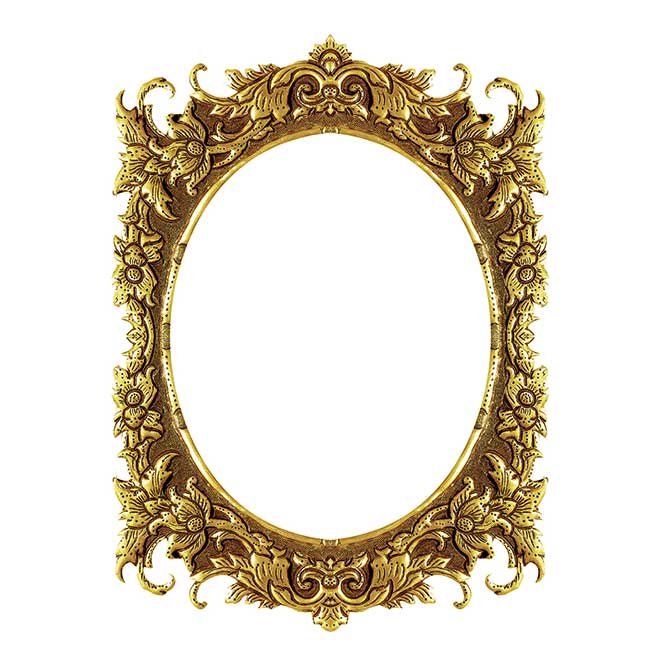timeless: mirrors
Famed decorator Dorothy Draper once stated, “Mirrors have come to mean much more than the original ‘looking glass.’ They are now a part of the decorative scheme of a modern home. By using them, there are no dark, gloomy corners, no drab caverns for halls. There can be a feeling of freedom, light, air, space.”
The earliest attempt to create a reflective mirror was about 6,000 years ago in Turkey using polished obsidian. At the same time, ancient Egyptians tried with polished copper, and the ancient Mesopotamians used polished metal. Romans invented the first glass mirrors (actually made with crude blown glass) in the 1st century. Socrates advised young men to look at themselves in the mirror; if they saw a handsome face, they should focus on avoiding the temptations of life. If they saw a plain face, they should concentrate on doing good works to compensate for their lack of beauty. This must have been the start of vanity! In the medieval period, many thought the devil was on the other side of a mirror watching them, a belief that continued until the 13th century.
Venetian masters were the first to develop flat mirrors. They discovered how to attach glass to tin and coat the back of the glass with a mixture of gold and bronze, which improved the reflection. The cost of these small mirrors was comparable to that of a large naval ship at the time, so they were symbols of great wealth.
In the 15th century, the risk of fires in Venice forced all its glassmakers to move to the island of Murano, which became known as the ‘Isle of Glass.’ Italy dominated the mirror market and managed to keep its methods undisclosed for almost 200 years. French politician Jean-Baptiste Colbert, a minister under King Louis XIV, bribed three Murano masters with gold and brought them to France. The French had no problem learning the secret techniques of the Italians, and they further perfected the process. They developed a way to ‘roll’ the glass as it was cooling to create a smooth and even consistency.
Following this invention, construction of the Hall of Mirrors at Versailles began. The 220-foot-long gallery was embellished with 306 huge mirrors. Never had any installation of mirrors been so grand and opulent. The obsession was widespread. French queen Marie de Medici created an office with 119 mirrors; King Henry VIII of England and King Francis I of France also were major collectors. A mirror the size of a painting by Italian Renaissance artist Raphael would cost just as much!
Thankfully, mirrors are now affordable on any budget. They still add glamour, utility, whimsy and sophistication to a room. What began as a polished stone to reflect an image is now a commonplace element of every home.
what’s in a name
Sister Parish Since I was born in 1962, I never had the chance to meet many of the great interior designers who have given me so much inspiration. Sister Parish is at the top of my list. Born Dorothy May Kinnicutt in 1910, she was called ‘Sister’ because she had four brothers. This nickname often confused the press, as they thought she was a nun with a talent for arranging furniture!
She began her career as a decorator in 1930 in a one-room office in Far Hills, New Jersey, to help with her family’s income. From this humble beginning, she went on to become a famed partner in the firm Parish Hadley (formed in 1962 with Albert Hadley) and was recognized as one of the great American interior decorators.
She might be best known for her understated and eclectic country house look, though she emphatically denied allegiance to any particular style. “From the beginning, I never followed trends,” Parish once said. “If I was aware of them, I didn’t care, for … rooms should be timeless and very personal. I don’t set out to achieve a particular style.” Her rooms never looked ‘decorated,’ but more like old friends gathered to create an interesting environment. It proves that instinct is often what makes a great decorator!
Parish created exquisite, well-defined formal interiors as well. She was the first professional decorator hired to work in the White House (and the first to be fired). Jacqueline Kennedy recruited her to design the family’s private quarters. Many well-known decorators started their careers working with Parish, including Bunny Williams, Mark Hampton and Mario Buatta. She died in 1994, and Hadley ran the firm for many years after her death.
For a good read on Sister Parish, I recommend the book by her daughter and granddaughter, Sister: The Life of Legendary American Interior Decorator Mrs. Henry Parish II.
50 shades of golden plumberia
Autumn is just around the corner, and I love fall colors. When you think about the hues of each season, there is a natural progression. February red livens to a geranium pink for spring, and deepens to russet in the fall. Think of your favorite color. You should notice different versions of it in nature throughout the year as the climate and light change it.
I enjoy the color yellow in all shades. Yellow is always happy, never sad. Even as the season changes and it takes on the deeper golds of fall and winter, it remains happy. Yellow can be sophisticated or whimsical. It acts as a great neutral, and almost any other color works well with it. The color Golden Plumeria from Sherwin Williams is a great example of the perfect harvest yellow for fall.
